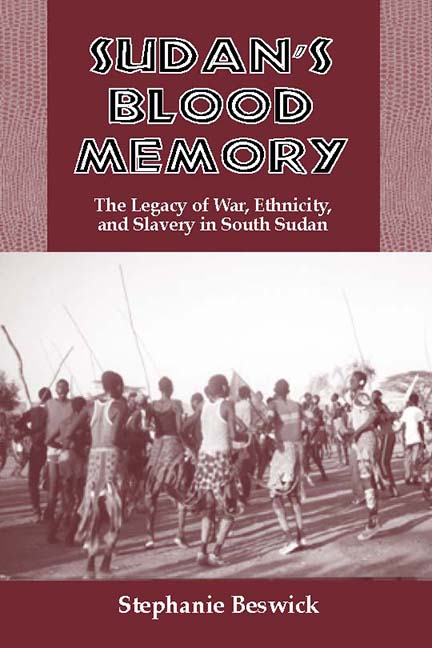Book contents
- Frontmatter
- Dedication
- Contents
- Maps
- Preface
- Acknowledgments
- A Note on Orthography and Languages
- A Note on Sources
- Map
- 1 Introduction
- 2 Geography and Brief History of Sudan
- 3 The Changing Nilotic Frontier
- The Ethno-Historical Formation of Southern Sudan
- The Ascendancy of the Dinka in Southern Sudan
- Foreign Intrusion and Its Consequences
- 15 Eighteenth-Century Slavers and Traders
- 16 Nilotic Chaos: Dinka, Nuer, Atwot, and Anyuak
- 17 Politics and Stratification among Stateless Peoples
- 18 Summary and History
- 19 Legacy of the Precolonial Era
- Notes
- Glossary
- Bibliography
- Index
19 - Legacy of the Precolonial Era
from Foreign Intrusion and Its Consequences
Published online by Cambridge University Press: 23 July 2019
- Frontmatter
- Dedication
- Contents
- Maps
- Preface
- Acknowledgments
- A Note on Orthography and Languages
- A Note on Sources
- Map
- 1 Introduction
- 2 Geography and Brief History of Sudan
- 3 The Changing Nilotic Frontier
- The Ethno-Historical Formation of Southern Sudan
- The Ascendancy of the Dinka in Southern Sudan
- Foreign Intrusion and Its Consequences
- 15 Eighteenth-Century Slavers and Traders
- 16 Nilotic Chaos: Dinka, Nuer, Atwot, and Anyuak
- 17 Politics and Stratification among Stateless Peoples
- 18 Summary and History
- 19 Legacy of the Precolonial Era
- Notes
- Glossary
- Bibliography
- Index
Summary
The memory of war and blood over the centuries, remembered in myths and oral histories, has framed the psychology of much of the modern-day South Sudanese populace, particularly the Dinka. Indeed, this “blood memory” dominates the actions of all modern-day peoples in this part of Africa. The emotions, however, that accompany these memories are reserved for both those beyond their northern frontier as well as those within their homelands who have been enemies for centuries.
“Primordialism” is a scholarly term that presumes that cultures remain static over long time periods. South Sudanese society has not remained dormant, but rather has been vibrant over the centuries and undergone enormous changes. The British colonial era introduced Christianity (which was not successful until very recent years) and Western education into the region. In the 1970s a vibrant Western-educated middle class in Southern Sudan began to flourish. In modern times factors such as the means by which wars are fought, particularly the introduction of guns, and the inclusion of women into the military have changed society drastically.
Certain historical themes, however, have continued to dominate and play a critical role in the sociopolitical and religious cultures of South Sudan today, particularly among the Western Nilotic peoples who predominate numerically. The themes include the ongoing predatory attacks by the North, the southward moving Nilotic (and hence South Sudanese) frontier and migrations, intra-Southern fears of Dinka expansion, the economic and numerical predominance of the Dinka, the “raiding complex,” social stratification, the importance of blood lines, Nilotic fission politics versus centralization, religion and politics, slave raids, gender dominance and lineage slavery, and, last but not least, the ongoing ethnic conflicts and “blood memories.” In these instances emotions that are attached to the memories of previous wars, killings, and misdeeds die hard. Less prominent but equally important, however, both historically and in modern times, is that there has always been ethnic accommodation. Each of the above factors will be dealt with in turn below.
The Changing Nilotic Frontier and Long-Distance Migrations
Today the Nilotic frontier and the frontier of South Sudan has come to mean the same thing. What is clear by looking at the long history of the Nilotes in Sudan is that this boundary has been shifting southwards for centuries and has never been fixed.
- Type
- Chapter
- Information
- Sudan's Blood Memory , pp. 198 - 222Publisher: Boydell & BrewerPrint publication year: 2004

